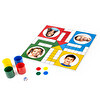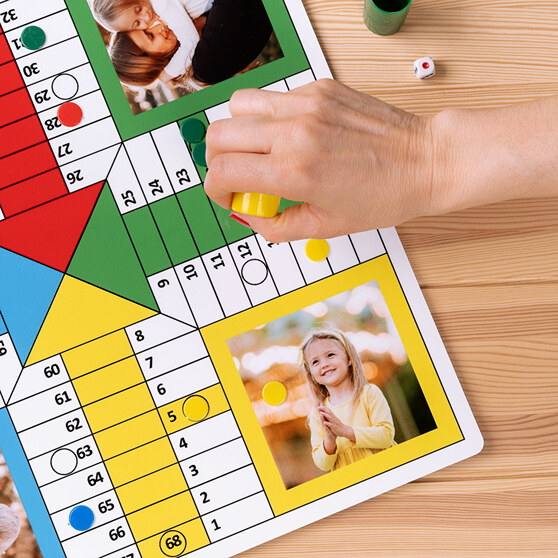





Personalised Ludo & Game of the Goose
£8.86
Deliver between 8-9 January with fast shippingPlace your order before 8 hours 26 min.
In stock
Model

Ludo (cardboard)
20x20cm
£8.86

Ludo (wood)
34,5x34,5cm
£17.76

Game of the goose (wood)
34,5x34,5cm
£17.76

Ludo & Game of the goose (wood)
34,5x34,5cm
£26.66
Details
- Measurements: 20 cm (width) x 20 cm (height) x 0,3 cm (thickness)
- No minimum quantity, from 1 unit
- Material: ecological cardboard.
- Designs available for 4 players.
- Cups and dices included.
- In this ludo game, the "house" of each player is personalised.
- In the goose game, some squares and the centre of the board are personalised.
- ID: #17345
- More details
designs
Reviews
4.41
107 opinions
5
- 70%
4
- 14%
3
- 7%
2
- 6%
1
- 4%

richard (Praha 5, CZ)
Purchased: Ludo & Game of the Goose Ludo (wood) 02/12/25
I'd add more forms of man, don't be angry. It would be ideal to have a custom printed cover for the board itself.
Text automatically translated.See original message
caty (TOURS, FR)
Purchased: Ludo & Game of the Goose Ludo (cardboard) 19/10/25
I can turn my photos one in each direction. It's great.
Text automatically translated.See original message
T
tineke (Wognum, NL)
Purchased: Ludo & Game of the Goose Ludo (cardboard) 15/04/25
Fun game with pictures.
Text automatically translated.See original message
sangia (MOLLET DEL VALLES, ES)
Purchased: Ludo & Game of the Goose Ludo (wood) 19/03/25
I love the new product, it is very light
Text automatically translated.See original message
hans (Hillegom, NL)
Purchased: Ludo & Game of the Goose Game of the goose (wood) 26/02/25
Nice quality, fast delivery
Text automatically translated.See original message
N
nuno (SANTA CATARINA DA FONTE D, PT)
Purchased: Ludo & Game of the Goose Ludo (wood) 08/01/25
My order W05640304 came damaged, as you can see in the picture, and the game didn't even come with a box. None of my pre...
Text automatically translated.See original message
Description
The traditional Parcheesi and Game of the Goose.. now personalised!
We have completely personalised games such as Game of the goose and Ludo. Add pictures of you and your family to make them more personal and you will get to have a different board to the original one. You can buy the complete pack and spend more hours playing with the family while having a lot of fun together. It is an ideal gift for Christmas.
They are classics that never go out of fashion and are great to play with friends and family. Because there is nothing better than playing old but personalised board games with the ones you love. Because there is nothing better than reviving those afternoons of board games with whom you want to play board games with.
They are sold on two different boards, one with game of the goose and the other one on a ludo board. We also include the cups and dices so that as soon as you receive them you can start playing the games. But what sets them apart from other board games, is the personalisation. You’ll be able to personalise the boards as you with. It also means that you won’t find any other ludo or Game of the Goose board games in any shop or store.
p>In the personalised ludo, the "house" of each player is personalised and you can add the photo of the player in his/hers favourite colour. While in the personalised game of the goose 14 boxes and the center of the board can be personalised. Those boxes belong to the ones that make you jump from Goose to Goose.It is a must in any home and now you have the opportunity to have the most exclusive model with your favorite photos. Revive all the old memories together with your family and play our personalised game.

Personalised Ludogame
Parcheesi with photos! No matter how many years go by, Parcheesi will always be the king of all board games. Once you start a game, you won’t be able stop until you find a winner! And if it's a personalised parcheesi game, it's going to be even more fun. You can personalise each "house" on the board, so that the players have their own personalised area, with their favourite photo or image.
Material: MDF wood with a polyester coating.
How to play Ludo
The rules of Ludo vary slightly from country to country, but the basic rules remain the same. The general rules for Ludo are:

These are the basic rules, but there are some additional rules that make the game more interesting. Again, we insist, in each country there may be variations and different ways of playing Ludo, but here we talk about the most common and usual rules.
Rules for the start
When it comes to getting your pieces out of your house, it's not enough to just roll the dice and see what comes up. There are some specific rules:
- In order to get a piece out of your house, you have to throw a 6 with the dice
- If a double 5(if playing with two dices) is rolled, the player has the choice: either to get 2 pieces out of the house and place them together on their starting square (the small square of their colour). Or he can get one piece out, and immediately move 6 squares with that same piece.
- The first square that is found when the player comes out is that player's starting square. It is the player's colour. If that square is already occupied by 2 pieces, and the player who owns that square rolls a 6 and must therefore draw a piece, the pieces that were occupying that square will have to return to their starting square (unless they are the player's own pieces).
Rules for the development of the game
Now that we have seen the rules for the start of the game, let's have a look at other rules that are used during the course of the game:
- The numbers on the dice roll can be split. For example, if you roll a 2 and a 5, you can advance two squares with one piece and five squares with the other. Or you can add up the roll and advance seven squares with the same piece(if you’re playing with 2 dices).
- When the player only has 1 piece in play, he cannot split the dices and is obliged to roll the sum of the dice with this piece(if playing with 2 dices).
- When a piece enters the corridor to enter the goal, it is rolled with only one dice(if playing with 2 dices).
- To enter the goal, you are required to roll the exact number of squares remaining. If you go too far, it bounces back.
How to send another player's pieces back to their home
Getting “sent back” is the most damaging thing that can happen to a Ludo player. Or, seen from the other side, being “sent back” is the most beneficial for the other players.
When a player rolls the dice, moves the pieces, and one of them ends his move on the same square as another player's piece, he sends it back to start. When this happens, the piece that is landed on will be sent back to start and will have to roll a 6 again, in order to get the piece out of their home again.
Exception: on the board there are some squares with a circle in the middle. These squares are "safe", and the pieces are safe there. They cannot be sent back home if they are standing on those squares.
Rules for the pieces arrival at the goal
When a piece reaches the goal, the player can roll the dices one more time as a prize.
How to make a blockage in Ludo
If a player places 2 pieces of their colour on the same square, the other players cannot cross that square and are obliged to wait for it to be broken. However, if the player who has these pieces rolls a double on their turn, then they are obliged to move the pieces of the blockages, and therefore open it.
What are the origins of Ludo (board game)?
The original name is pachisi, and it was invented in India in the 16th century. Parcheesi is a variation of this first original game. The name Ludo came from England in 1896.
The design was created based on the gardens of Emperor Abdul Momin. The centre of the board represents the throne where the emperor sat in his courtyard. On the other hand, the counters represent Indian women who moved in order to play for the emperor.
Personalised Game of the Goose
The traditional board game, Game of the Goose, now reinvented. Make your own design and play with your family and friends the traditional Game of the Goose game in a totally different way, you will be the most original of all! Get this game made with the latest printing technology and be surprised by its quality.
You can personalise the centre of the board (the goal of the game) with a large photo. And also 14 squares along the course of the game, with 14 different photos. These personalised squares are the ones where you jump "from goose to goose".
Rules: How to play Game of the Goose
These are the basic rules, briefly explained:
- Number of players: 2 to 4. Recommended age: 4 years and up.
- Each player participates with a different coloured piece.
- The aim of the game is to reach the centre of the board first, the big square. This is the goal.
- The game is played in turns. A player chosen at random starts. In each turn, the player throws 1 dice and moves forward as many squares as the dice roll indicates.
- The squares on the board are all numbered, and some of them have special features for special actions, which we will see later.
Rules for each special square
When it is a player's turn, he rolls the dice and moves his piece forward as many squares as the number that comes up indicates.

- If the player lands on a GOOSE square (in our personalised goose game, these are the squares that have a personalised photo) he/she wins the right to advance to the next GOOSE square, and can also repeat and roll the dice again. When this happens we say: "From goose to goose I jump, because it’s my turn to have fun".
- If you land on a BRIDGE square (square 6 and 12) you have to move your piece to the other bridge. In other words, you either move forward from square 6 to square 12, or you move back from square 12 to square 6. Then you roll again. When this happens it is said: "from bridge to bridge and I roll because I am carried away by the current".
- When you land in the inn, you are out of play for one turn (you are said to be sleeping in the inn).
- If you land on the WELL square, you cannot roll the dice again until another player passes that square. You must wait for rescue to get out of the pit.
- If you are unlucky enough to land on the MAZE square, you will be forced to move back to square 30.
- You can fall into the CARCEL square, and that means 2 turns without playing.
- There are two squares called DICE (26 and 53), which work in the same way as the bridge: if you land on one of these squares, you move to the other, and roll again. Here we say "from dice to dice and I roll because it's my turn to roll".
- The worst square in the game is the CAVE square (58). If you land there, the piece goes back to the start, to square 1. The game starts all over again.
The rest of the squares have various drawings and have no effect when you land on them.
To reach the finish line, you have to roll the exact number of squares you have left to reach the finish line. If you overshoot, you bounce and go back a few squares.
How was Game of the Goose invented?
The origin of the game of the goose is somewhat unclear and there are several theories or possible authors. One theory, for example, holds that the first versions of the game appeared at the end of the 19th century and were decorated with illustrations related to that time.
The strongest theory says that the first version was a game that Francis I de Medici of Florence gave to Philip II of Spain in the mid-16th century.
But the origin is also said to be much older, as the game is said to have been invented by the Greeks in about the 13th century BC. There was an archaeological discovery, the Phaistos Disc, dating back to 2,000 BC, which could confirm this origin.
Advantages of ChromaLuxe Gloss Wood
- Images are infused directly into our special coated wood laminates, creating unparalleled colour vibrancy and resolution.
- Unique substrates and coatings provide incredible scratch and abrasion resistance.
- These wood prints last a lifetime with resistance to yellowing and weather damage.
- These panels can be wiped clean with a cloth and any all-purpose cleaner, allowing your image to shine without a problem.

